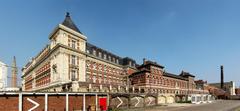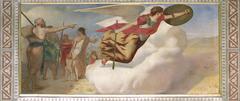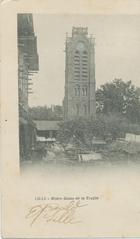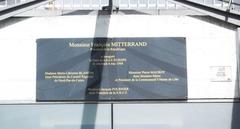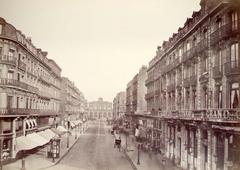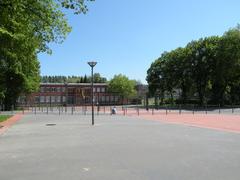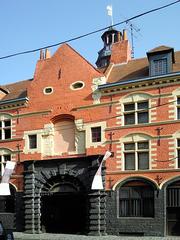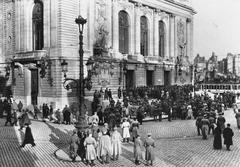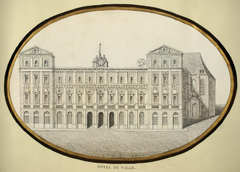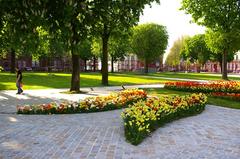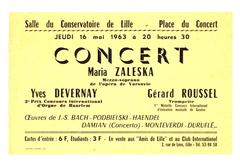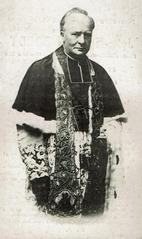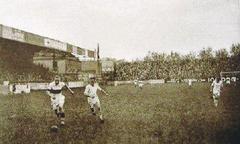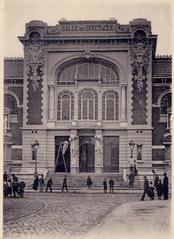
Prefecture Hotel of Nord Lille: Visiting Hours, Tickets, and Historical Guide
Date: 04/07/2025
Introduction
Nestled in the vibrant heart of Lille, the Hôtel de la Préfecture du Nord is an outstanding example of 19th-century French civic architecture and a living testament to Lille’s rich history and ongoing role in regional governance. Serving as the administrative headquarters for the Nord department—the most populous in France—this historic building continues to be a focal point for public administration and cultural identity. Its central location on Place de la République, impressive Second Empire façade, and proximity to major cultural landmarks make it an essential stop for anyone interested in Lille’s heritage.
This comprehensive guide explores the Prefecture’s history, architectural features, civic significance, and provides practical information for visitors. Whether you’re drawn by the building’s architecture, its role in French governance, or its place within Lille’s vibrant urban landscape, planning your visit with the right information will ensure a memorable experience.
(info.lenord.fr)
(lenord.fr)
(Hauts-de-France Tourism)
Contents
- Brief History of the Hôtel de la Préfecture du Nord
- Architectural Highlights
- Civic Role and Administrative Importance
- Visiting Information: Hours, Tickets, and Accessibility
- Guided Tours and Special Events
- Nearby Attractions
- Practical Visitor Tips
- Frequently Asked Questions (FAQ)
- Conclusion
Brief History of the Hôtel de la Préfecture du Nord
The foundation stone of the Hôtel de la Préfecture du Nord was laid on August 15, 1865, during a period of rapid urban expansion in Lille. By then, Lille had recently annexed surrounding municipalities like Wazemmes and Fives, tripling the city’s size. The new Prefecture was envisioned as the administrative heart of the Nord department and as a symbol of Lille’s importance as a regional capital.
Throughout its history, the building has played a central role in governance, civil defense, and the implementation of national policies. It also bore witness to major events, including the German occupation during both World Wars and the city’s liberation in 1944. Recognized as a historic monument since 1975, the Prefecture remains a powerful symbol of both civic pride and state authority.
Architectural Highlights
The Prefecture is a quintessential representation of the Second Empire style, showcasing a symmetrical façade, elegant classical columns, and intricate stonework. Constructed from durable limestone, the building features an imposing main entrance with allegorical sculptures that represent governance, justice, and civic identity. A ceremonial courtyard (cour d’honneur) welcomes visitors, while the central pavilion and wings are topped with distinctive slate roofs.
Interior highlights include:
- Grand Staircase and Entrance Hall: Marble-clad and designed for ceremonial grandeur.
- Reception Salons: Lavishly decorated with period furnishings and chandeliers, used for official receptions.
- Council Chamber (Hémicycle): The semi-circular assembly hall for departmental meetings, with tiered seating and a central podium.
- Art Nouveau Secretariat: A unique feature reflecting the building’s administrative function.
- Gardens and Courtyard: Landscaped green spaces providing a peaceful retreat in the city center.
Ornate ceilings, classical moldings, and period artwork further emphasize the building’s role as a symbol of government authority and regional prestige.
(Nomads Travel Guide)
(Wikipedia - Préfecture de Lille)
Civic Role and Administrative Importance
The Hôtel de la Préfecture du Nord is the administrative center for the Nord department, which has over 2.6 million inhabitants (Kiddle). As the seat of the Prefecture, it implements national policies locally, ensures public order, and manages civil services such as residence permits and citizenship applications. The building also coordinates with surrounding communes and supports major regional events, including the Braderie de Lille, the largest flea market in Europe.
In addition to its governmental function, the Prefecture acts as a bridge between Lille’s historic core and newer neighborhoods, reinforcing its symbolic role in the city’s evolution and civic life.
(Titres de Séjour)
(Hauts-de-France Tourism)
Visiting Information: Hours, Tickets, and Accessibility
- Opening Hours: The Prefecture is generally not open for regular public visits. Public access is possible during special events such as European Heritage Days (Journées Européennes du Patrimoine) held annually in September.
- Tickets and Reservations: Admission is free during special open days, but reservations are mandatory due to limited capacity. Visit the official Nord department website for current dates and booking details.
- Accessibility: The building is partially accessible. Visitors with reduced mobility should contact the Prefecture in advance to arrange accommodations.
Guided Tours and Special Events
Guided tours are offered primarily during European Heritage Days and select special occasions. These tours provide rare access to the building’s ceremonial rooms, council chamber, and historical exhibits, with knowledgeable guides sharing insights into the Prefecture’s history and architecture.
Due to the building’s administrative function, tours are not available year-round and must be booked in advance through official channels.
Nearby Attractions
Make the most of your visit by exploring these nearby Lille highlights:
- Palais des Beaux-Arts: One of France’s largest fine arts museums, located directly opposite the Prefecture.
- Grand Place (Place du Général de Gaulle): The city’s main square, renowned for its vibrant atmosphere.
- Vieille Bourse (Old Stock Exchange): A stunning example of 17th-century Flemish Renaissance architecture.
- Vieux Lille: The picturesque Old Town, known for its narrow streets, boutiques, and Flemish-inspired buildings.
- Town Hall Belfry: A UNESCO World Heritage site offering panoramic views of Lille.
(budgetyourtrip.com)
(theworldwasherefirst.com)
Practical Visitor Tips
- Best Time to Visit: European Heritage Days in mid-September provide the best opportunity for public access.
- Photography: Exterior photography is permitted. Interior photography is subject to restrictions during guided tours.
- Security: Be prepared for security checks and bring a valid photo ID.
- Dress Code: Dress respectfully, especially when attending official functions or ceremonies.
- Language: French is the primary language; consider bringing translated documents if necessary.
- Transportation: The Prefecture is easily accessible by metro (République – Beaux-Arts station, Line 1), tram, and buses.
Frequently Asked Questions (FAQ)
Q: What are the visiting hours?
A: The Prefecture is generally closed to the public, except during special events like European Heritage Days. Always check the official website for the latest updates.
Q: Is there an admission fee?
A: Admission is free during public open days, but advance reservation is required.
Q: Are guided tours available year-round?
A: No, guided tours are only available during special events and must be booked in advance.
Q: Is the building accessible for people with disabilities?
A: The Prefecture is partially accessible. Contact the administration ahead of your visit for specific accommodations.
Q: Can I take photographs inside?
A: Photography is generally permitted in public areas during open days, but some rooms may have restrictions.
Conclusion
The Hôtel de la Préfecture du Nord in Lille is much more than a government building—it is a living monument to the city’s historical evolution, architectural grandeur, and civic identity. While regular public access is limited, special events like European Heritage Days offer a unique chance to experience its richly decorated interiors and ceremonial spaces. Its central location makes it an ideal starting point for exploring Lille’s premier cultural attractions, including the Palais des Beaux-Arts, Grand Place, and Vieux Lille.
To optimize your visit, plan ahead by consulting the official Nord department website, take advantage of guided tours during public openings, and use resources like the Audiala app for curated cultural content and travel tips. Immerse yourself in the Prefecture’s storied past and architectural splendor to connect with Lille’s vibrant heritage and dynamic civic life.
References & Resources
- info.lenord.fr
- lenord.fr
- Hauts-de-France Tourism
- Nomads Travel Guide
- Wikipedia - Préfecture de Lille
- France This Way
- Art Facts
- blog-student-place.com
- Kiddle
- Titres de Séjour
- budgetyourtrip.com
- theworldwasherefirst.com

